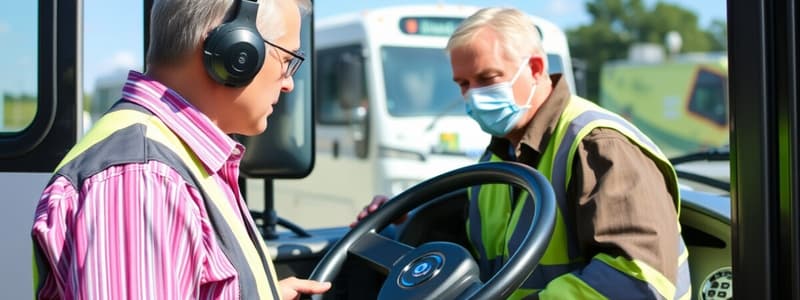Podcast
Questions and Answers
What should be checked at the front of the bus?
What should be checked at the front of the bus?
- Bus level and air leaks
- Windshield cracks and illegal stickers
- Wipers and blades condition
- All of the above (correct)
What is the minimum tread depth for front tires?
What is the minimum tread depth for front tires?
- 8/32"
- 2/32"
- 4/32" (correct)
- 6/32"
Rear suspensions on buses are equipped with springs.
Rear suspensions on buses are equipped with springs.
False (B)
What should you check for in the engine compartment?
What should you check for in the engine compartment?
What indicates that the parking brake is functioning correctly?
What indicates that the parking brake is functioning correctly?
What should the temperature gauge indicate?
What should the temperature gauge indicate?
The ______ is securely mounted and charged in the driver's compartment.
The ______ is securely mounted and charged in the driver's compartment.
Match the following components with what you should check:
Match the following components with what you should check:
What should be done to the wheelchair ramp before deploying?
What should be done to the wheelchair ramp before deploying?
Brake pads should be too thin to function properly.
Brake pads should be too thin to function properly.
How should you check the front suspension?
How should you check the front suspension?
How should the driver's seat be adjusted?
How should the driver's seat be adjusted?
What indicates a proper exterior light check?
What indicates a proper exterior light check?
What should be done regarding the rear brakes?
What should be done regarding the rear brakes?
Flashcards
Front of Bus Inspection
Front of Bus Inspection
Bus is level, no air leaks, mirrors are secure and in good condition, no windshield cracks or illegal stickers, functional wipers/blades, lights are secure and undamaged.
Front Wheel Inspection
Front Wheel Inspection
Minimum 4/32" tread depth, no retreads, no abrasions, intact valve caps/stems, correct tire inflation, undamaged rims, secure lug nuts, no hub seal leaks, adequate oil level.
Steering Parts Inspection
Steering Parts Inspection
Steering box securely mounted, no damage/leaks, all nuts/bolts present, undamaged/leak-free power steering hoses, steering linkage checked for wear/cracks, secure joints.
Front Suspension Inspection
Front Suspension Inspection
Signup and view all the flashcards
Front Brakes Inspection
Front Brakes Inspection
Signup and view all the flashcards
Rear Wheel Inspection
Rear Wheel Inspection
Signup and view all the flashcards
Rear Suspension Inspection
Rear Suspension Inspection
Signup and view all the flashcards
Rear Brakes Inspection
Rear Brakes Inspection
Signup and view all the flashcards
Right Side Inspection
Right Side Inspection
Signup and view all the flashcards
Under Bus Inspection
Under Bus Inspection
Signup and view all the flashcards
Rear of Bus Inspection
Rear of Bus Inspection
Signup and view all the flashcards
Engine Compartment Inspection
Engine Compartment Inspection
Signup and view all the flashcards
Passenger Entry Inspection
Passenger Entry Inspection
Signup and view all the flashcards
Interior Inspection
Interior Inspection
Signup and view all the flashcards
Study Notes
Front of Bus
- Ensure bus is level, with no lean; listen for air leaks.
- Check mirrors for security and condition; inspect windshield for cracks and illegal stickers.
- Verify wipers and blades are functional and free from weather damage.
- Confirm all lights are securely mounted and undamaged; amber clearance and parking lights must be checked.
Front Axle - Front Wheel
- Tread depth must be a minimum of 4/32" and should not be retreaded; inspect for abrasions.
- Ensure valve caps and stems are intact, and check tire inflation with a gauge.
- Check rims for denting or damage and confirm lug nuts are properly fastened without rust trails.
- Absence of leaks around hub seal and adequate oil level must be verified.
Steering Parts
- Steering box should be securely mounted without damage or leaks; all nuts and bolts must be present.
- Ensure power steering hoses are undamaged and leak-free.
- Examine steering linkage for wear or cracks; joints must be secure without loose bolts.
Front Suspension
- Confirm no springs are present; check for damage or missing bushings.
- Air ride suspension needs to be securely mounted with no air leaks; shocks should also be intact.
- Examine U-bolts and torsion bars for secure attachment and damage.
Front Brakes
- Brake hoses must be undamaged and free of leaks; chambers should be securely mounted without sign of issues.
- Inspect brake rotors and pads for wear and contaminants; slack adjuster movement must be less than 1".
Rear Axle - Rear Wheels
- Tread depth must be a minimum of 2/32" with no abrasions on tires.
- Confirm rim integrity with no signs of illegal repairs; check lug nuts for security.
- Axle seal should not leak and oil level must be sufficient; ensure no foreign objects are stuck between wheels.
Rear Suspension
- Verify absence of springs; check for secure mounting of air ride suspension without leaks.
- Shocks and air bag mounts should be intact; inspect torsion bars and U-bolts for security.
Rear Brakes
- Check hoses and brake chambers for damage or leaks; rotors and pads should be free from wear.
- Ensure slack adjuster and pushrod are securely mounted with limited movement upon brake release.
Right Side of Bus
- Ensure clearance lights and reflectors are intact; fuel tank must be secure and leak-free.
- Fuel cap should be tightly fastened and undamaged.
Under the Bus
- Check drive shaft integrity between rear wheels and engine; ensure U-joints are secure.
- Longitudinal and cross members must be intact; exhaust system should be free of damage or leaks.
Rear of Bus
- Look for any leaks underneath; ensure security of lights and reflectors, with red clearance lights.
Engine Compartment
- Verify oil, coolant, and power steering fluid levels are appropriate using sight glasses or dipsticks.
- Check engine components for secure mounting, signs of leaks, and functional operation.
Passenger Entry
- Inspect entry doors, seals, and steps for security and cleanliness; all handrails and step lights must be functional.
Interior
- Ensure no broken or improperly mounted seat frames; check for rail security.
Emergency Exits
- Confirm that emergency exits, including roof and window exits, are in working condition and operate smoothly.
Wheelchair Ramp
- Ensure ramp is securely mounted and operational; follow specific procedures for deploying and stowing the ramp.
Driver's Compartment
- Fire extinguisher must be charged and correctly mounted; confirm presence of three red reflective triangles and spare fuses if applicable.
Driver's Seat
- Driver's seat must adjust properly; ensure seatbelt is secure and free from damage.
Safe Start
- Gear shifter must be securely mounted; transmission should be in neutral before starting the engine.
Gauges
- Monitor temperature, amp, oil pressure, and air pressure gauges for normal readings during operation.
Dashboard
- Check functionality of turn signal and high beam indicators, as well as the horn and wipers; ensure windshield visibility is clear.
Exterior Light Check
- Conduct thorough check of all exterior lights including hazards, turn signals, clearance, and tail lights before the examiner walks outside.
Brake Tests
- Perform comprehensive tests for parking brake, psi loss, air warning check, and service brake accuracy under controlled conditions.
End of Inspection
- Inform examiner upon completion of a thorough pre-trip inspection; address any missed items as necessary.
Studying That Suits You
Use AI to generate personalized quizzes and flashcards to suit your learning preferences.




